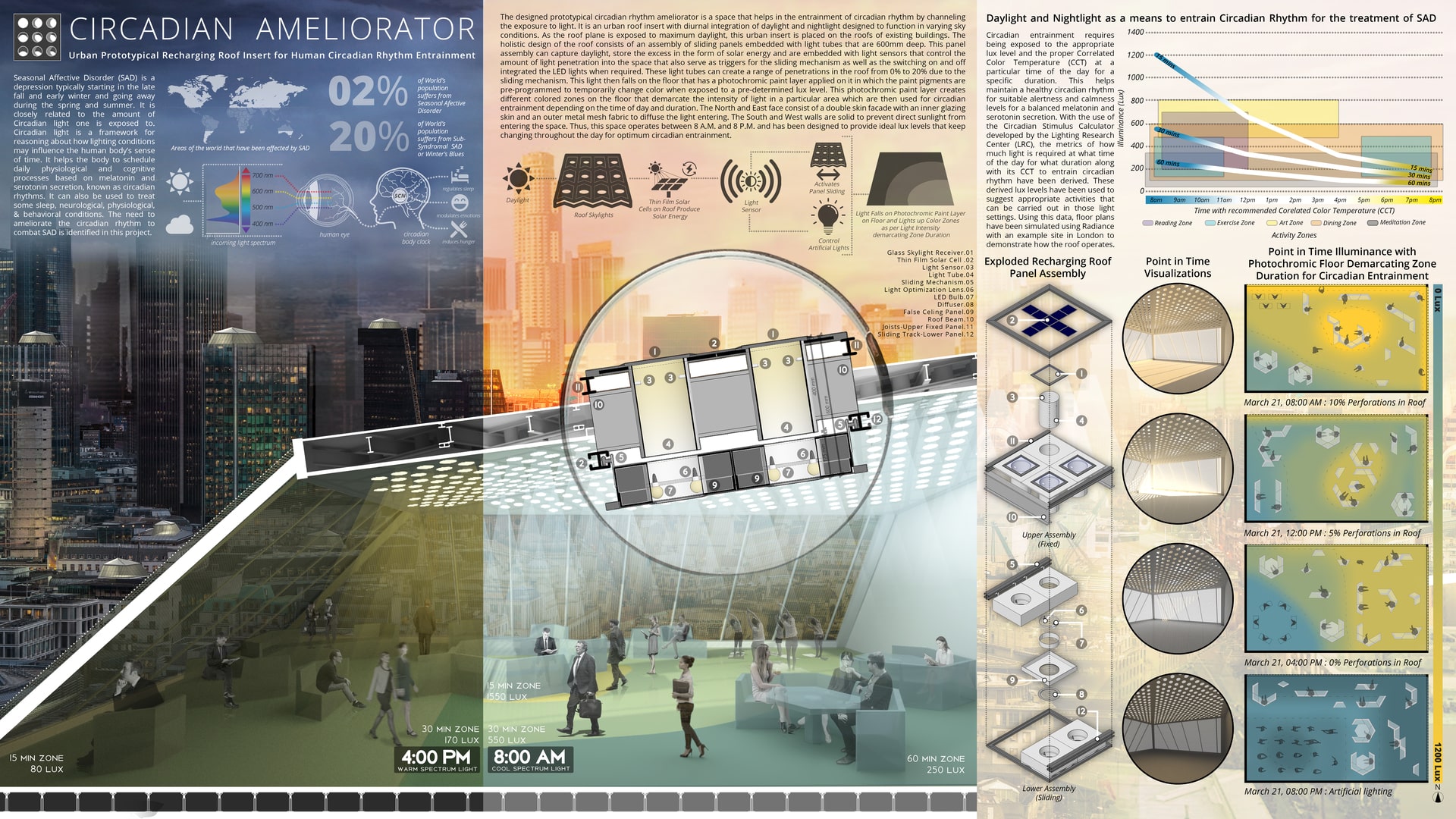Project Description
CIRCADIAN AMELIORATOR: Urban Prototypical Recharging Roof Insert for Human Circadian Rhythm Entrainment Cir-ca-di-an: recurring naturally on a 24-hr cycle, even in the absence of light A-me-lio-rate: make something bad or unsatisfactory better Keywords: SAD, Entrain Circadian Rhythm, Prototypical Roof Insert, Dynamic Roofs, Controlled Perforations, Urban-Scale, Recharge Declarative: Seasonal Affective Disorder or SAD is a form of depression that is caused by a reduced exposure to natural daylight and is related to changes in seasons. SAD begins and ends at about the same times every year, typically starting in the late fall and early winter and going away during the spring and summer. In simpler terms, the human brain must receive a set amount of light throughout the day and when it doesn’t, many functions like sleeping patterns, alertness and mood get affected as it disrupts the human biological clock, also known as the Circadian Rhythm. The Circadian Rhythm regulates the secretion of the hormones melatonin and serotonin that helps the body to schedule daily physiological and cognitive processes. Statistics show that 2% of the world’s population is severely affected by SAD and 20% of the population is affected by Winter Blues or Subsyndromal SAD. The need to ameliorate the Circadian Rhythm to combat SAD is identified in this project. New Prototypical Insert: Increase in the disruption of Circadian Rhythms over 50 years because of SAD has created a need for a recharging space that can provide adequate lighting conditions over the day to entrain the Circadian Rhythms. It is estimated that the number of people suffering from SAD is likely to escalate in the future due to an increase in indoor centric lifestyle and increased urban building density. This intervention is thus most required at an urban scale. The designed prototypical circadian rhythm ameliorator is a space that helps in the entrainment of circadian rhythm by channeling the exposure to light. It is an urban roof insert with diurnal integration of daylight and nightlight designed to function in varying sky conditions. As the roof plane is exposed to maximum daylight, this urban insert is placed on the roofs of existing buildings. The proposed space can be adapted to the roofs of existing buildings in dense urban conditions to facilitate alertness inducing lighting conditions during the day and calmness inducing lighting conditions during the night by capitalizing on daylight and artificial light. Mechanism: The holistic design of the roof consists of an assembly of sliding panels embedded with light tubes that are 600mm deep. This panel assembly can capture daylight, store the excess in the form of solar energy and is embedded with light sensors that control the amount of light penetration into the space that also serve as triggers for the sliding mechanism as well as the switching on and off integrated the LED lights when required. These light tubes can create a range of penetrations in the roof from 0% to 20% due to the sliding mechanism, allowing the space to have varied lighting conditions throughout the year. Circadian entrainment requires being exposed to the appropriate lux level and the proper Correlated Color Temperature (CCT) at a particular time of the day for a specific duration. This helps maintain a healthy circadian rhythm for suitable alertness and calmness levels for a balanced melatonin and serotonin secretion. With the use of the Circadian Stimulus Calculator developed by the Lighting Research Center (LRC), the metrics of how much light is required at what time of the day for what duration along with its CCT to entrain Circadian Rhythm have been derived. Daylight penetrates through the roof and falls on the floor that has a photochromic paint layer applied on it in which the paint pigments are pre-programmed to temporarily change color when exposed to the pre-determined lux levels from the LRC Calculator. This photochromic paint layer creates different colored zones on the floor that demarcate the intensity of light in a particular area which are then used for circadian entrainment depending on the time of day and duration. These zones that have specific lux levels have been used to suggest appropriate activities that can be carried out in those light settings. Conclusion: Thus, this design intervention identifies an issue and its theoretical solution, designs a technology to concretize the solution into a practical daylight intervention when backed by research in the field of daylighting and materials and uses radiance simulations to evaluate and support the design claim.
